The Sinus Irrigation Systems Market is estimated to be valued at USD 244.8 million in 2025 and is projected to reach USD 1325.5 million by 2035, registering a compound annual growth rate (CAGR) of 18.4% over the forecast period.
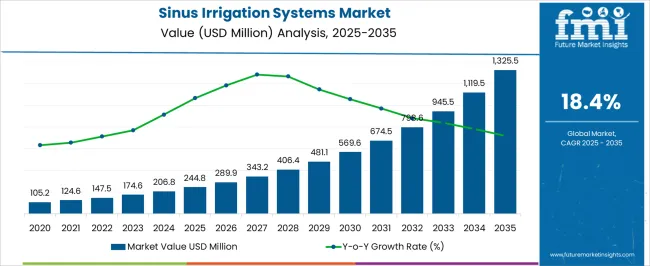
| Metric | Value |
|---|---|
| Sinus Irrigation Systems Market Estimated Value in (2025 E) | USD 244.8 million |
| Sinus Irrigation Systems Market Forecast Value in (2035 F) | USD 1325.5 million |
| Forecast CAGR (2025 to 2035) | 18.4% |
The Sinus Irrigation Systems market is experiencing steady growth driven by the increasing prevalence of chronic sinus conditions and growing awareness about preventive and self-managed healthcare solutions. The market is being shaped by rising consumer preference for home-based treatments that reduce the need for frequent clinical visits. Advancements in product design, ease of use, and accessibility of sinus irrigation systems have contributed to their growing adoption.
Increasing investment in patient education and homecare infrastructure is facilitating wider acceptance, particularly among patients seeking non-invasive and cost-effective solutions. The adoption of self-care devices is further being encouraged by the expansion of e-commerce platforms, which improve product availability and convenience.
Additionally, the growing focus on respiratory health, especially in populations affected by allergies, seasonal infections, and environmental pollutants, is expected to drive demand With healthcare systems increasingly supporting home-based care models and preventive treatment regimens, sinus irrigation systems are positioned to continue capturing significant market share, presenting opportunities for product innovation and enhanced patient engagement.
The sinus irrigation systems market is segmented by type of product, end user, and geographic regions. By type of product, sinus irrigation systems market is divided into Manual Sinus Irrigation Systems, Neti Pots, Squeeze Bottles, Bulb Syringes, Electric Sinus Irrigation Systems, and Battery Powered Sinus Irrigation Systems. In terms of end user, sinus irrigation systems market is classified into Homecare Settings, Hospitals, and ENT clinics. Regionally, the sinus irrigation systems industry is classified into North America, Latin America, Western Europe, Eastern Europe, Balkan & Baltic Countries, Russia & Belarus, Central Asia, East Asia, South Asia & Pacific, and the Middle East & Africa.
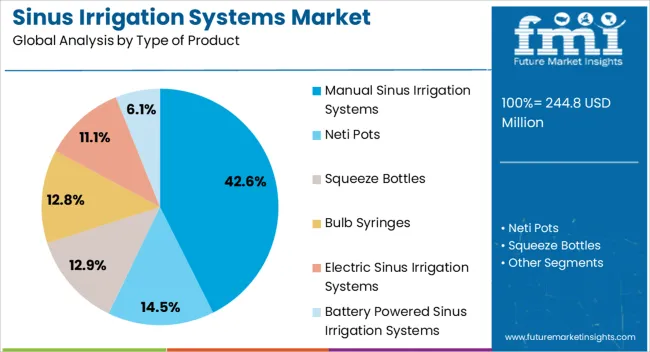
Manual Sinus Irrigation Systems are projected to hold 42.60% of the Sinus Irrigation Systems market revenue in 2025, establishing this segment as the leading type of product. The dominance of manual systems is being attributed to their simplicity, cost-effectiveness, and ease of use, which allow patients to perform nasal irrigation independently without specialized training or equipment.
These systems are favored for their portability, low maintenance requirements, and ability to deliver precise saline flow, which supports effective sinus cleansing. The segment’s growth is further driven by rising consumer awareness of non-pharmacological interventions for sinus care, as well as increased focus on hygiene and respiratory health.
Additionally, the flexibility of these devices for home use makes them suitable for patients of all age groups, enabling long-term adoption and adherence Continuous product innovations aimed at improving ergonomics, user comfort, and solution delivery are expected to reinforce the segment’s leadership and sustain its growth trajectory in the foreseeable future.
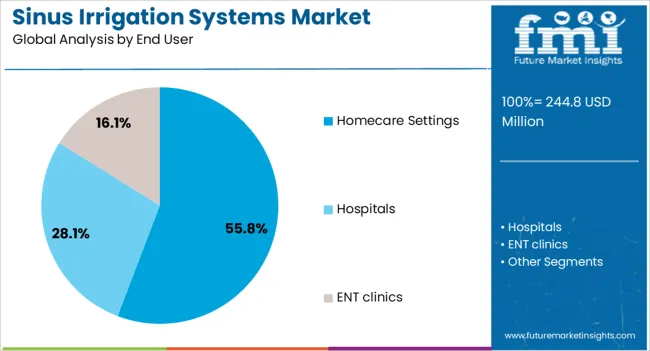
The Homecare Settings end-use segment is anticipated to account for 55.80% of the Sinus Irrigation Systems market revenue in 2025, making it the largest end-use category. The prominence of homecare usage is being driven by the increasing preference for self-administered treatments, which reduce the need for frequent clinical interventions and associated costs.
Homecare adoption is supported by the growing availability of easy-to-use sinus irrigation devices and educational initiatives that empower patients to manage chronic sinus conditions independently. Convenience, accessibility, and cost-efficiency are key factors that have enhanced the popularity of home-based sinus care.
Furthermore, heightened awareness of respiratory health, allergies, and sinus infections has increased the adoption of preventive and therapeutic practices in domestic environments The trend toward remote healthcare management and non-invasive treatment options is reinforcing the preference for homecare settings, while continued development of user-friendly, safe, and portable devices is expected to sustain growth in this segment over the coming years.
Allergies is the most common reason for sinus problems. Another common cause of sinusitis is that of dry nose. Dry nose leads to congestion, thickened mucus and worsened sinusitis. Some of the common causes for excessive mucus formation in the upper respiratory tract include, allergies, infection and excessive heat leading to dry nose, sinusitis and other similar problems.
One of the earliest records for the use of sinus irrigation systems is found in the ancient Hindu practice of Ayurveda. It was customary to perform jala-neti daily for maintain nasal hygiene.
Sinus irrigation can effectively relive symptoms of both chronic and acute sinusitis caused by upper respiratory tract infections such as cold and allergic rhinitis. Sinus irrigation systems are used for flushing the nasal cavity to sooth inflamed tissue and remove allergens and mucous. The Neti pot is the most common type of sinus irrigation systems.
It relies on gravity and the head position for the rinsing of the sinus cavity. The Neti pot type of sinus irrigation systems have a long spout attached near the bottom with a handle on the other end. A number of squeeze bottle type of sinus irrigation systems are also available.
Similarly, bulb syringe type of sinus irrigation systems are available and are popularly used for infants and children. Some of the latest designs of sinus irrigation systems are motorized and are driven either by electricity or may be battery powered.
However there are a number of precautions that is required during the use of sinus irrigation systems. For an instance, the water used for sinus irrigation must be distilled, sterile or boiled. Another important factor that may negatively impact the use of sinus irrigation systems is not properly cleaning the device regularly. Unsafe water and unclean pots and devices may lead to increasing infections and result in worsening the sinusitis symptoms.
Sinus Irrigation Systems market witnessing the maximum growth in near future owing to increase in patient pool globally. The increased number of allergy cases and the rise in flu and common cold are the major drivers for the growth of the sinus irrigation systems. Low cost and easy portability of Sinus Irrigation Systems make it most suitable to be used in homecare settings.
The availability of electric units that make it easier to use in clinics as well as home setting further allows the market to have potential growth during the forecast period.
Global Sinus Irrigation Systems market is expected to gain significant growth rate over the forecast period. Sinus Irrigation Systems is expected to gain high demand in forecast periods due to increasing in patient pool. The increasing patient pool worldwide is mainly due to rising cases of allergy related inflammation and sinus issues that is driving the growth of global Sinus Irrigation Systems market.
However the risk of infections is high and may overall hinder the growth of the Sinus Irrigation Systems market.
In terms of geography, Sinus Irrigation Systems market has been divided into eight regions including North- America, Eastern Europe, Western Europe, and Asia- Pacific excluding China & Japan (APECJ), China, Japan, Middle-East & Africa and Latin America. North America is the most dominating market for Sinus Irrigation Systems market due to the rise in per capita expenditure on healthcare and technological advancement.
Western European countries such as Germany, France, and the UK are top revenue contributing courtiers in Western Europe. The Asia Pacific excluding China and Japan Sinus Irrigation Systems market is expected to expand at fastest growth rate over the forecast period due to increasing local players and fast and increasing adoption of sinus irrigation practice.
China is the one of the important revenue contributing country in global Sinus Irrigation Systems market due to the availability of cost-effective Sinus Irrigation Systems and large patient pool in the region.
The report is a compilation of first-hand information, qualitative and quantitative assessment by industry analysts, inputs from industry experts and industry participants across the value chain. The report provides in-depth analysis of parent market trends, macro-economic indicators and governing factors along with market attractiveness as per segments. The report also maps the qualitative impact of various market factors on market segments and geographies.
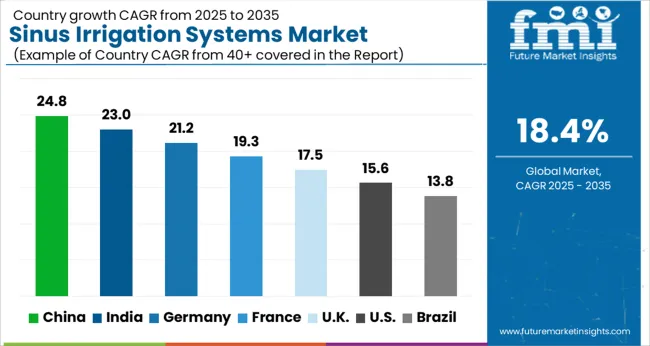
| Country | CAGR |
|---|---|
| China | 24.8% |
| India | 23.0% |
| Germany | 21.2% |
| France | 19.3% |
| UK | 17.5% |
| USA | 15.6% |
| Brazil | 13.8% |
The Sinus Irrigation Systems Market is expected to register a CAGR of 18.4% during the forecast period, exhibiting varied country level momentum. China leads with the highest CAGR of 24.8%, followed by India at 23.0%. Developed markets such as Germany, France, and the UK continue to expand steadily, while the USA is likely to grow at consistent rates. Brazil posts the lowest CAGR at 13.8%, yet still underscores a broadly positive trajectory for the global Sinus Irrigation Systems Market. In 2024, Germany held a dominant revenue in the Western Europe market and is expected to grow with a CAGR of 21.2%. The USA Sinus Irrigation Systems Market is estimated to be valued at USD 87.5 million in 2025 and is anticipated to reach a valuation of USD 374.3 million by 2035. Sales are projected to rise at a CAGR of 15.6% over the forecast period between 2025 and 2035. While Japan and South Korea markets are estimated to be valued at USD 11.1 million and USD 7.0 million respectively in 2025.
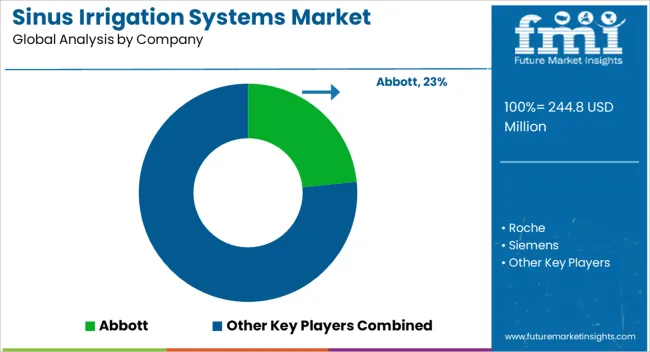
| Item | Value |
|---|---|
| Quantitative Units | USD 244.8 Million |
| Type of Product | Manual Sinus Irrigation Systems, Neti Pots, Squeeze Bottles, Bulb Syringes, Electric Sinus Irrigation Systems, and Battery Powered Sinus Irrigation Systems |
| End User | Homecare Settings, Hospitals, and ENT clinics |
| Regions Covered | North America, Europe, Asia-Pacific, Latin America, Middle East & Africa |
| Country Covered | United States, Canada, Germany, France, United Kingdom, China, Japan, India, Brazil, South Africa |
| Key Companies Profiled | Abbott, Roche, Siemens, Nova Biomedical, Johnson & Johnson, Danaher, LifeScan, AgaMatrix, and Medtronic |
The global sinus irrigation systems market is estimated to be valued at USD 244.8 million in 2025.
The market size for the sinus irrigation systems market is projected to reach USD 1,325.5 million by 2035.
The sinus irrigation systems market is expected to grow at a 18.4% CAGR between 2025 and 2035.
The key product types in sinus irrigation systems market are manual sinus irrigation systems, neti pots, squeeze bottles, bulb syringes, electric sinus irrigation systems and battery powered sinus irrigation systems.
In terms of end user, homecare settings segment to command 55.8% share in the sinus irrigation systems market in 2025.






Our Research Products

The "Full Research Suite" delivers actionable market intel, deep dives on markets or technologies, so clients act faster, cut risk, and unlock growth.

The Leaderboard benchmarks and ranks top vendors, classifying them as Established Leaders, Leading Challengers, or Disruptors & Challengers.

Locates where complements amplify value and substitutes erode it, forecasting net impact by horizon

We deliver granular, decision-grade intel: market sizing, 5-year forecasts, pricing, adoption, usage, revenue, and operational KPIs—plus competitor tracking, regulation, and value chains—across 60 countries broadly.

Spot the shifts before they hit your P&L. We track inflection points, adoption curves, pricing moves, and ecosystem plays to show where demand is heading, why it is changing, and what to do next across high-growth markets and disruptive tech

Real-time reads of user behavior. We track shifting priorities, perceptions of today’s and next-gen services, and provider experience, then pace how fast tech moves from trial to adoption, blending buyer, consumer, and channel inputs with social signals (#WhySwitch, #UX).

Partner with our analyst team to build a custom report designed around your business priorities. From analysing market trends to assessing competitors or crafting bespoke datasets, we tailor insights to your needs.
Supplier Intelligence
Discovery & Profiling
Capacity & Footprint
Performance & Risk
Compliance & Governance
Commercial Readiness
Who Supplies Whom
Scorecards & Shortlists
Playbooks & Docs
Category Intelligence
Definition & Scope
Demand & Use Cases
Cost Drivers
Market Structure
Supply Chain Map
Trade & Policy
Operating Norms
Deliverables
Buyer Intelligence
Account Basics
Spend & Scope
Procurement Model
Vendor Requirements
Terms & Policies
Entry Strategy
Pain Points & Triggers
Outputs
Pricing Analysis
Benchmarks
Trends
Should-Cost
Indexation
Landed Cost
Commercial Terms
Deliverables
Brand Analysis
Positioning & Value Prop
Share & Presence
Customer Evidence
Go-to-Market
Digital & Reputation
Compliance & Trust
KPIs & Gaps
Outputs
Full Research Suite comprises of:
Market outlook & trends analysis
Interviews & case studies
Strategic recommendations
Vendor profiles & capabilities analysis
5-year forecasts
8 regions and 60+ country-level data splits
Market segment data splits
12 months of continuous data updates
DELIVERED AS:
PDF EXCEL ONLINE
Wound Irrigation Systems Market Growth - Trends & Forecast 2025 to 2035
Functional Endoscopic Sinus Surgery Systems Market Size and Share Forecast Outlook 2025 to 2035
Irrigation Syringe Market Size and Share Forecast Outlook 2025 to 2035
Sinus Dilation Devices Market Size and Share Forecast Outlook 2025 to 2035
Systems Administration Management Tools Market Size and Share Forecast Outlook 2025 to 2035
Sinus Therapeutic Drugs Market – Trends, Growth & Forecast 2022-2032
Irrigation testing kit Market
Irrigation Liners Market
VRF Systems Market Growth - Trends & Forecast 2025 to 2035
Micro Irrigation System Market Size and Share Forecast Outlook 2025 to 2035
Cloud Systems Management Software Market Size and Share Forecast Outlook 2025 to 2035
Hi-Fi Systems Market Size and Share Forecast Outlook 2025 to 2035
Cough systems Market
Smart Irrigation Market
Wound Irrigation Devices Market
Dental Irrigation Devices Market
Suction Irrigation Devices Market Analysis Size and Share Forecast Outlook 2025 to 2035
Backpack Systems Market Size and Share Forecast Outlook 2025 to 2035
Unmanned Systems Market Analysis - Size, Share, & Forecast Outlook 2025 to 2035
DC Power Systems Market Trends - Growth, Demand & Forecast 2025 to 2035

Thank you!
You will receive an email from our Business Development Manager. Please be sure to check your SPAM/JUNK folder too.
Chat With
MaRIA